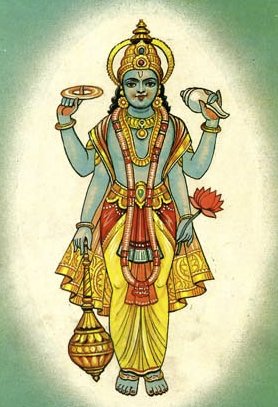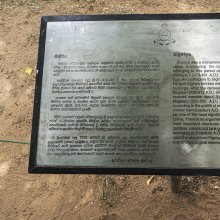Palana, Pālana, Pālanā, Palāṉa, Palaṅa: 21 definitions
Introduction:
Palana means something in Hinduism, Sanskrit, Buddhism, Pali, Marathi, Jainism, Prakrit, Hindi, Tamil. If you want to know the exact meaning, history, etymology or English translation of this term then check out the descriptions on this page. Add your comment or reference to a book if you want to contribute to this summary article.
Alternative spellings of this word include Palna.
Images (photo gallery)
In Hinduism
Vaishnavism (Vaishava dharma)
Source: Prabhupada Books: Sri Caitanya CaritamrtaPālana (पालन) or Pālanaśakti refers to “ruling and maintaining the living entities ”, according to the Śrī Caitanya Caritāmṛta 2.20.246 (“The Science of the Absolute Truth”).—(Cf. Śaktyāveśa).—The śaktyāveśa-avatāras are categorized into (1) forms of divine absorption (bhagavad-āveśa), such as Kapiladeva or ṛṣabhadeva, and (2) divinely empowered forms (śaktyāveśa), of whom seven are foremost: [i.e., (6) Mahārāja Pṛthu, specifically empowered to rule and maintain the living entities (pālana-śakti) , [...]”.

Vaishnava (वैष्णव, vaiṣṇava) or vaishnavism (vaiṣṇavism) represents a tradition of Hinduism worshipping Vishnu as the supreme Lord. Similar to the Shaktism and Shaivism traditions, Vaishnavism also developed as an individual movement, famous for its exposition of the dashavatara (‘ten avatars of Vishnu’).
Shaivism (Shaiva philosophy)
Source: Brill: Śaivism and the Tantric TraditionsPālana (पालन) refers to the “performance (of post-initiatory rites)” [?], according to the Jayadrathayāmala, Ṣaṭka 1 verse 13.3–18::—Accordingly, “[...] Besides (bhūyas) the nirvāṇadīkṣā bestowing liberation is of many kinds: śivadharma-dīkṣā, lokadharma-dīkṣā and the initiation which kills quickly, causing the body to fall. [The initiation] which reveals everything through the attainment of Śiva through the performance of post-initiatory rites (samayācāra-pālana) once the three bonds (i.e. the three impurities) have ceased due to the purification of the consciousness on one [of the six] paths, [that] initiation is known to be the śivadharmadīkṣā, which bestows the attainment of liberation because it is contrary to the mundane practice. [...]”.

Shaiva (शैव, śaiva) or Shaivism (śaivism) represents a tradition of Hinduism worshiping Shiva as the supreme being. Closely related to Shaktism, Shaiva literature includes a range of scriptures, including Tantras, while the root of this tradition may be traced back to the ancient Vedas.
Purana and Itihasa (epic history)
Source: archive.org: Shiva Purana - English TranslationPālana (पालन) refers to “sustenance” (being the task of Brahmā), according to the Śivapurāṇa 2.5.7 (“The gods pray”).—Accordingly, as Śiva said to the Gods: “[...] O Brahmā, O Viṣṇu, you are the lord of the three worlds, to be sure. Hence provide me with the paraphernalia of an emperor. You too had been entrusted with the tasks of creation (sarga) and sustenance (pālana). You shall make all efforts, considering the destruction of the three cities an act of help to the gods. [...]”.

The Purana (पुराण, purāṇas) refers to Sanskrit literature preserving ancient India’s vast cultural history, including historical legends, religious ceremonies, various arts and sciences. The eighteen mahapuranas total over 400,000 shlokas (metrical couplets) and date to at least several centuries BCE.
Languages of India and abroad
Pali-English dictionary
Source: BuddhaSasana: Concise Pali-English Dictionarypālana : (nt.) protection; preservation; government. || pālanā (f.) protection; preservation; government.
Source: Sutta: The Pali Text Society's Pali-English DictionaryPālanā, (f.) (fr. pāleti cp. Ep. Sk. pālana nt. ) guarding, keeping J. I, 158; Dhs. 19, 82, 295. (Page 455)
— or —
Pālana, (nt.) (& pālanā?) (fr. pāleti 2, to all likelihood for palāyana through *pālāna, with false analogy) moving, running, keeping going, living, in phrase vutti pālana yapana etc. at Vism. 145; DhsA. 149 167; also in defn of bhuñjati1 as “pālan’ajjhohāresu” by eating & drinking for purposes of living, at Dhtp 379. As pālanā at the Dhs. passages of same context as above (see under yapana). (Page 455)

Pali is the language of the Tipiṭaka, which is the sacred canon of Theravāda Buddhism and contains much of the Buddha’s speech. Closeley related to Sanskrit, both languages are used interchangeably between religions.
Marathi-English dictionary
Source: DDSA: The Molesworth Marathi and English Dictionarypalāṇa (पलाण).—n (palyayana S) A packsaddle (esp. of camels and elephants). Ex. pṛtanāvastrēṅkarūna || ghātalēṃ pṛthvīsa pa0 ॥. 2 Applied to the saddle of a horse on the first occasion of putting the saddle to him; also to the act of saddling a horse for the first time. v kara. 3 fig. A ridge of earth connecting a well &c. with some distant spot.
--- OR ---
paḷaṇa (पळण).—n paḷaṇī f paḷapaṭa f paḷāpaḷa f (paḷaṇēṃ) A general flight (as of people before the enemy, or of an army under sauve qui peut.) 2 paḷaṇa & paḷaṇī are more general--fleeing or wild running. See paḷaṇī below.
--- OR ---
pālana (पालन).—n (S) Preserving, nourishing, cherishing, protecting. 2 Keeping, maintaining, observing (of a vow, a promise &c.)
--- OR ---
pālāṇa (पालाण).—& pālāṇaṇēṃ See palāṇa & palāṇaṇēṃ.
--- OR ---
pāḷaṇa (पाळण).—n (pālana S) Preserving, nourishing, cherishing. 2 Keeping or maintaining (of a vow or promise): also observing, regarding, reverently holding (an observance, ordinance, rite).
--- OR ---
pāḷaṇā (पाळणा).—m (pāḷaṇēṃ) A child's cradle. 2 A box of the turn-cross erected at fairs &c. 3 A lullaby (as of the infant-feats of kṛṣṇa) sung over the cradle. v gā, mhaṇa. Ex. aiśā rīti viśvajananī || pā0 gātasē tayē kṣaṇīṃ ||.
Source: DDSA: The Aryabhusan school dictionary, Marathi-Englishpalāṇa (पलाण).—n A packsaddle.
--- OR ---
paḷaṇa (पळण).—n paḷaṇī f paḷapaṭa f paḷāpaḷa f A general flight
--- OR ---
pālana (पालन).—n Preserving. Keeping, maintaining.
--- OR ---
pāḷaṇa (पाळण).—n Preserving. Maintaining. Observing.
--- OR ---
pāḷaṇā (पाळणा).—m A cradle. A box of the turn- cross erected at fairs &c. A lullaby.
Marathi is an Indo-European language having over 70 million native speakers people in (predominantly) Maharashtra India. Marathi, like many other Indo-Aryan languages, evolved from early forms of Prakrit, which itself is a subset of Sanskrit, one of the most ancient languages of the world.
Sanskrit dictionary
Source: DDSA: The practical Sanskrit-English dictionaryPālana (पालन).—a. [pāl-bhāve lyu lyuṭ vā] Protecting, guarding &c.; Kirātārjunīya 1.1.
-nam 1 Protecting, guarding, nourishing, cherishing, fostering; लब्ध° (labdha°) R.19.3; so प्रजा°, क्षिति° (prajā°, kṣiti°), &c.
2) Maintaining, observing, keeping (as a promise, vow &c.)
3) The milk of a cow that has recently calved.
4) the sharpening (of arms); शस्त्राणां पालनं ज्ञानं (śastrāṇāṃ pālanaṃ jñānaṃ) Mahābhārata (Bombay) 12.59.46 (com. śastrāṇāṃ pālanaṃ tīkṣṇīkaraṇam).
Source: Cologne Digital Sanskrit Dictionaries: Edgerton Buddhist Hybrid Sanskrit DictionaryPalāna (पलान).—pple. (= [Jaina Māhārāṣṭrī] palāṇa, Pischel 567, compare prec., and § 34.19), fled, or sometimes seemingly with pass. force, put to flight, with instr. of person causing the flight, e.g. bhagavatā te (mss. tena) amanuṣyakā (demons) palānā Mahāvastu i.270.11—12; so several times Mahāvastu i.283.7 ff., regularly with instr.; used absolutely, without instr., fled, Mahāvastu ii.172.16; 235.2; iii.350.1. Cf. also palāyaka, with v.l. palānaka, and prapalāna.
Source: Cologne Digital Sanskrit Dictionaries: Shabda-Sagara Sanskrit-English DictionaryPālana (पालन).—n.
(-naṃ) 1. Preserving, guarding, protecting, cherishing, nourishing. 2. The milk of a cow that has recently calved. E. pāl to nourish, aff. lyuṭ .
Source: Cologne Digital Sanskrit Dictionaries: Benfey Sanskrit-English DictionaryPālana (पालन).—[pāl + ana], i. e. pā, [Causal.], + ana, I. adj., f. nī, Guarding, fostering, Mārk. P. 76, 23. Ii. n. 1. Preserving, guarding, [Mānavadharmaśāstra] 7, 88; nourishing. 2. Maintaining, keeping, Mahābhārata 1, 327.
Source: Cologne Digital Sanskrit Dictionaries: Cappeller Sanskrit-English DictionaryPālana (पालन).—[adjective] ([feminine] ī) & [neuter] keeping, guarding, protecting, observing.
Source: Cologne Digital Sanskrit Dictionaries: Monier-Williams Sanskrit-English Dictionary1) Pālana (पालन):—[from pāl] mf(ī)n. guarding, nourishing (nī jananī f. a foster-mother), [Mārkaṇḍeya-purāṇa]
2) [v.s. ...] n. the act of guarding, protecting, nourishing, defending, [Manu-smṛti; Mahābhārata] etc.
3) [v.s. ...] maintaining, keeping, observing, [Mahābhārata; Kāvya literature] etc.
4) [v.s. ...] n. the milk of a cow that has recently calved, [cf. Lexicographers, esp. such as amarasiṃha, halāyudha, hemacandra, etc.] (-karman n. superintendence, [Śakuntalā]; -vṛtti f. a [particular] manner of subsistence, [Baudhāyana-dharma-śāstra])
Source: Cologne Digital Sanskrit Dictionaries: Yates Sanskrit-English DictionaryPālana (पालन):—(naṃ) 1. n. Preserving; milk of a cow lately calved.
Source: DDSA: Paia-sadda-mahannavo; a comprehensive Prakrit Hindi dictionary (S)Pālana (पालन) in the Sanskrit language is related to the Prakrit word: Pālaṇa.
[Sanskrit to German]
Sanskrit, also spelled संस्कृतम् (saṃskṛtam), is an ancient language of India commonly seen as the grandmother of the Indo-European language family (even English!). Closely allied with Prakrit and Pali, Sanskrit is more exhaustive in both grammar and terms and has the most extensive collection of literature in the world, greatly surpassing its sister-languages Greek and Latin.
Hindi dictionary
Source: DDSA: A practical Hindi-English dictionary1) Palanā (पलना) [Also spelled palna]:—(nm) a cradle; (v) to be brought up, to be reared/fostered; to be nourished.
2) Pālana (पालन) [Also spelled palan]:—(nm) abiding by; observance; upbringing; nourishing, fostering; tending; maintenance; -[poṣaṇa] upbringing; nourishing/providing nourishment, fostering; nurture/nurturing; mothering, bringing up, cherishing; ~[hāra] one who tends/rears/fosters/brings up; God; —[karanā] to abide by; to observe; to nurture, to mother, to foster, to bring up.
3) Pālanā (पालना) [Also spelled palna]:—(v) to bring up, to rear; to nurture; to foster; to feed, to mother; to tame, to domesticate; (nm) a (swinging) cradle/crib; [pālā-posā] brought up, nourished, reared.
...
Prakrit-English dictionary
Source: DDSA: Paia-sadda-mahannavo; a comprehensive Prakrit Hindi dictionary1) Palāṇa (पलाण) in the Prakrit language is related to the Sanskrit word: Palāyita.
Palāṇa has the following synonyms: Palāia.
2) Palāṇa (पलाण) also relates to the Sanskrit word: Palāyana.
3) Pālaṇa (पालण) also relates to the Sanskrit word: Pālana.
Prakrit is an ancient language closely associated with both Pali and Sanskrit. Jain literature is often composed in this language or sub-dialects, such as the Agamas and their commentaries which are written in Ardhamagadhi and Maharashtri Prakrit. The earliest extant texts can be dated to as early as the 4th century BCE although core portions might be older.
Kannada-English dictionary
Source: Alar: Kannada-English corpusPalānā (ಪಲಾನಾ):—[adjective] of this kind, sort.
--- OR ---
Pālana (ಪಾಲನ):—
1) [adjective] observing or adhering to (as rules, customs, etc.).
2) [adjective] protecting; tending; taking care of.
3) [adjective] ruling, reigning (a country).
--- OR ---
Pālana (ಪಾಲನ):—[noun] = ಪಾಲನೆ [palane].
Kannada is a Dravidian language (as opposed to the Indo-European language family) mainly spoken in the southwestern region of India.
Tamil dictionary
Source: DDSA: University of Madras: Tamil LexiconPalāṉa (பலான) adjectival < idem. Definitely known, as a person or thing; இன்னதென்றறியப் பட்ட. [innathenrariyap patta.] Local usage
Tamil is an ancient language of India from the Dravidian family spoken by roughly 250 million people mainly in southern India and Sri Lanka.
See also (Relevant definitions)
Starts with: Palana-garnu, Palanaikkattan, Palanaikkattavan, Palanakarman, Palanalvetir, Palananem, Palanaposhana, Palanashakti, Palanashtam, Palanativira-caritra, Palanavala, Palanavan, Palanavetir, Palanavritti.
Ends with (+34): Abhipalana, Ajnapalana, Anupalana, Apalana, Apratipalana, Ashta-paripalana, Atmapalana, Bailapalana, Bhuipalana, Bhupalana, Cakrapalana, Duranupalana, Ghodapalana, Ghodepalana, Hamsa-kukhura-palana, Kartavyapalana, Kukhurapalana, Kulapalana, Kumarapalana, Lalanapalana.
Full-text (+96): Pashavapalana, Paripalana, Pashupalana, Pratipalana, Pallana, Palhana, Palna, Palayaka, Palyana, Palayana, Prapalana, Bhupalana, Pratijnapalana, Ajnapalana, Prajapalana, Tithipalana, Palapala, Pritana, Bhuipalana, Palanakarman.
Relevant text
Search found 15 books and stories containing Palana, Pālana, Pālanā, Palāṇa, Paḷaṇa, Palaṇa, Pālāṇa, Pāḷaṇa, Pālaṇa, Pāḷaṇā, Pālaṇā, Palāna, Palanā, Palānā, Palāṉa, Palaana, Palaṅa; (plurals include: Palanas, Pālanas, Pālanās, Palāṇas, Paḷaṇas, Palaṇas, Pālāṇas, Pāḷaṇas, Pālaṇas, Pāḷaṇās, Pālaṇās, Palānas, Palanās, Palānās, Palāṉas, Palaanas, Palaṅas). You can also click to the full overview containing English textual excerpts. Below are direct links for the most relevant articles:
The Markandeya Purana (Study) (by Chandamita Bhattacharya)
1.3: Characteristics of Purāṇa < [Chapter 1]
Brihad Bhagavatamrita (commentary) (by Śrī Śrīmad Bhaktivedānta Nārāyana Gosvāmī Mahārāja)
Verse 1.7.80 < [Chapter 7 - Pūrṇa (pinnacle of excellent devotees)]
Verse 1.6.66 < [Chapter 6 - Priyatama (the most beloved devotees)]
Verse 1.7.65 < [Chapter 7 - Pūrṇa (pinnacle of excellent devotees)]
Chaitanya Bhagavata (by Bhumipati Dāsa)
Verse 1.1.73 < [Chapter 1 - Summary of Lord Gaura’s Pastimes]
Verse 2.14.50 < [Chapter 14 - Yamarāja’s Saṅkīrtana]
Verse 2.3.48 < [Chapter 3 - The Lord Manifests His Varāha Form in the House of Murāri and Meets with Nityānanda]
Manusmriti with the Commentary of Medhatithi (by Ganganatha Jha)
Verse 7.144 < [Section XI - Customs-Duties]
Verse 7.88 < [Section VIII - Duties in Battle (saṅgrāma)]
Garga Samhita (English) (by Danavir Goswami)
Verse 8.13.117 < [Chapter 13 - A Thousand Names of Lord Balarāma]
Verse 1.18.9 < [Chapter 18 - Vision of the Universal Form]
Bhakti-rasamrta-sindhu (by Śrīla Rūpa Gosvāmī)
Verse 4.5.9 < [Part 5 - Anger (raudra-rasa)]

